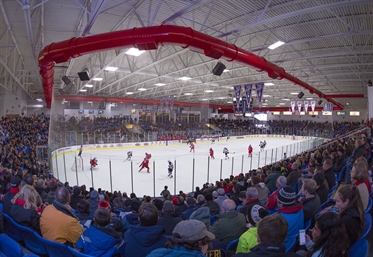USA Hockey settles in
USA Hockey settles in
Impressive new NTDP home in Plymouth

 USA Hockey Arena will house the country's National Team development Program. Photo: USA Hockey
USA Hockey Arena will house the country's National Team development Program. Photo: USA Hockey
How incredibly prophetic are two completely unrelated events that turn out to be, in a sense, like lost brothers who meet each other two decades later after having never known about each other.
Brother one. Peter Karmanos, who made his fortune as the president of Compuware, also owns the Hartford Whalers/Carolina Hurricanes franchise in the NHL and for many years owned a junior team in the OHL known briefly as the Detroit Whalers.
The Whalers had no home, so Karmanos built a two-pad arena in Plymouth, just outside Detroit, in the summer of 1996. One pad was NHL size with a seating capacity of 3,500; the other, Olympic size with a smaller seating structure. A year later, the team changed its name to Plymouth Whalers, and Karmanos owned the team until 2015 when he sold it and the new owners moved it to Flint, Michigan.
Brother two. Also in 1996, not far away, USA Hockey was establishing its National Team Development Program (NTDP) in Ann Arbor, Michigan. A greenhouse program, it identified the best pre-NHL draft players in the country and brought them together for one or two years, playing games in the USHL and also preparing for key IIHF tournaments, notably the U18 and U20 World Championship.
It’s impossible to overstate the success of the NTDP. It has taken the United States from a decent and respectable place in world hockey at the junior level to a place of great distinction and accomplishment, and it has developed dozens of NHL-drafted players, many of whom have gone on to brilliant pro careers.
But its success also showed some of the capacity limits the Ann Arbor facility, and like any great program that succeeds, it needed to expand.
Thus, the sale of the Whalers in 2015 left a superb complex looking for a tenant. USA Hockey purchased the facility from Karmanos and changed the name of Compuware Arena to USA Hockey Arena, ensuring the NTDP would have as brilliant a future as it had a past over the last two decades.
“For many years, we thought USA Hockey should have a place that was our own facility, a place we could showcase USA Hockey,” Jim Johannson, USA Hockey’s 2017 U20 general manager explained. “Obviously, our marquee team is the NTDP, but we also play in the USHL, and we wanted a facility to be fan friendly. It’s not just NTDP; it represents the best of USA Hockey. We have the Women’s Worlds coming, and other development programs in place. It had to be special.”
“Secondly, we needed to upgrade the facilities we were using for our elite programs. By taking control of that, we’re in good shape. We invested heavily in this facility, and that’s okay. We believe this will help USA Hockey membership as a whole. Certainly the players have been eager to play here.”
The facility is perfect for the organization. By and large, the U17s use the Olympic pad while the U18s use the NHL sheet. The one major change was the necessity of a new gym.
“The bones of this building are great,” Johannson continued. “We put in a 20,000 square foot workout room and offices for the NTDP, and we’re making further improvements in preparation for the Women’s Worlds, so we’ll continue to make it better. And there will be additional USA Hockey branding with the modern and the historical. We want young boys and girls to come in and see the history of what we’ve done in hockey, and do it in a first-class facility.”
As for naming the arena USA Hockey Arena, Johannson had no qualms about using the federation name instead of dedicating it to a great individual from the country’s past.
“There are opportunities inside for recognition, but the building as a whole was an easy decision to name it USA Hockey Arena,” he said.
And so two events that occurred simultaneously in 1996, having no connection to each other at all, are now made one. The Ann Arbor legacy lives on, but in a much more forward-looking space which bodes well for the future of the U18 and U20 events for the U.S.—and for the dozens of young men and women who hope to represent their country on the international stage.
Back to Overview














































